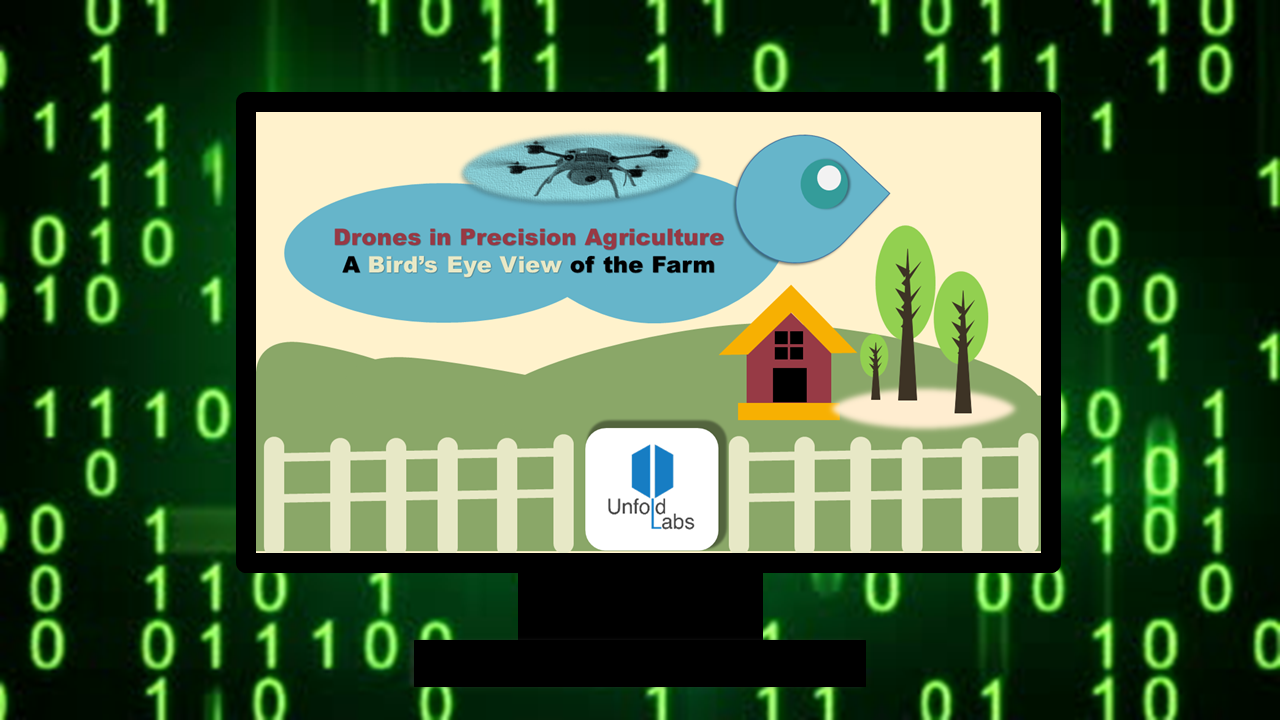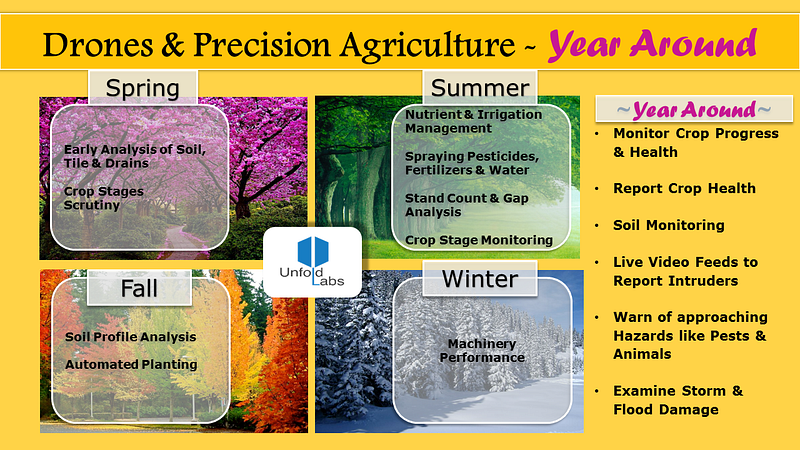Drones in Precision Agriculture
A Bird's Eye View of the Farm

Two interesting events occurred worldwide during the last couple of years; drones morphed into affordable technology and the Federal Aviation Administration (FAA) relaxed its norms for registering and operating drones. These changes triggered interesting events across industries. Though farming, an all-important industry around the globe, had been the least affected by the regulations from the FAA because of the low-altitude usage of drones, the moderations have given a big boost to making drones mainstream for farming and agriculture.
Drones, which a few years ago simply meant an important pollinator in the biosphere or a bee, today connotes an easy to use and more affordable technology in the skies for sustainable agriculture. Compared to satellite imagery or a manned aircraft, drones give a closer, more accurate, affordable and continuous view of farms divided into manageable zones.
Both commercial drones as well as DIY drones offer real-life solutions for agriculture with a noticeable edge through a complete mash-up of contemporary technologies. All these are controlled by specialized software designed for solutions, thus enabling precision farming.
Driving Techniques for Drones on the Farm

Interesting Reads from Around the World
Discussions, news and articles from leading sources over the last few years have foreseen the times to come, and the future of farming is certainly here now.
The Experts Speak
MIT Technology Review on Agricultural Drones
"Relatively cheap drones with advanced sensors and imaging capabilities are giving farmers new ways to increase yields and reduce crop damage."
NatGeo — Drones & The Future of Farming
"From driverless tractors to unmanned aerial vehicles (UAVs), farming technology is rapidly evolving. Farmers can use drones to identify specific plants that are diseased or infested with bugs, to save water and resources."
Market Watch discusses how drones are set to transform US agriculture with precision agriculture and the future of the agricultural robots market. It is predicted that drones will become more common in farms in 2017.Farmers across the country have interesting views about putting drones to intuitive uses. In Australia and New Zealand, extensive research is underway to bring huge changes to farming technology by 2025. The University of Southern Queensland is one of the pioneers in making drones as common as traditional farming equipment.
India, predicted to be one of the most promising economies in the next few years, gears up to bring affordable technology to its farmers. African countries like Uganda, Tanzania and Kenya, make use of drones to alert farmers of wandering animals and to prevent wildlife conflicts.
Smart farming disrupts the very basics in agriculture and drones do their part to speed up the transformation of the most important industry across the globe.
The Drones Flying Into the Smart Farms!
Farming continues to form the basis of economies across the world despite urbanization and industrialization. Besides feeding the population of a nation, agriculture has the potential to make a significant contribution to exports and help boost GDP of a country. The acknowledged importance of farming and farmers indicates why a touch of technology is required for this industry and how Smart Farming promises successful farming with technology. For farmers combating issues related to water, climate change and pollution, drones become the technology to look out for in the Smart Farming ecosystem.

Sky monitoring as a practice to support agriculture is already in place in several countries and the results are proving to be astounding. With drones, these only become more feasible and practical. The aerial captures lead to various assessments, warnings and signals and also measure, detect, and respond to variability in crops. Other uses of drones include:
Real-time Crop Monitoring & Scouting of the Smart Farms
Drones capture regular aerial views of vast fields to become the quintessential part of the Internet of Things (IoT) put to use in farms. Physical monitoring and scouting is reduced to increase farmer productivity using the Unmanned Aerial Vehicles (UAV)). The aerial cameras eliminate the irritants of satellite imagery with ease of access and do away with pre-ordering images.
- Monitor crop progress and health
- Report crop health
- Soil monitoring
- Live video feeds to report intruders
- Warn of approaching hazards like pests and animals
- Examine storm and flood damage
Drone Enabled Agricultural Intelligence
When used in conjunction with analytical tools, the accurate aerial shots from drones yields interesting insights.
Crop Stages Scrutiny
With constant monitoring of crops, the aerial views enable the generation of insights to drive timely actions for the crops from sowing to harvesting. Critical actions like watering and the need for pesticides are easily predicted and the farmer's response is prompted effectively.
Soil Profile Analysis
Drones play a vital role at the inception of crop cycle by generating 3-D maps that help determine soil health. This data is used to plot irrigation techniques and determine fruitful planting patterns depending on soil readiness for the next cycle.
Nutrient & Irrigation Management
Field analysis with inputs from data captured from the drones reveal areas deficit in specific nutrients and water. Drones also help determine the adequacy of these factors for crop growth during the complete crop cycle enabling quick corrective actions.
Generating Warnings & Alerts
Aerial views help assess issues with plants at any stage. Drones make it possible to capture challenging situations in the smallest areas within the farms ensuring appropriate warnings for preventative actions.
- Pest alerts
- Wandering animals
- Drowned out spots
- Weed pressure
- Bacterial & fungal infections
- Spoilt crop warnings

Drones — A Part of the Crop Cycle
Automated Planting
Actual seed planting through drones is already taking shape. Studies have indicated this will save planting effort by a huge percentage. Drone based planting systems will shoot seeds directly into the soil along with nutrients required.
Spraying Pesticides, Fertilizers & Water
Drones are empowered for ground scanning using distance measuring equipment, combined with lasers and ultrasonic techniques. This self-adjusting equipment stays away from collisions to dispense and spray the correct amount of substances from the required altitude. Spraying with drones increases process efficiency and precision while eliminating waste and also helps in reduced labor costs.
The Driving Technologies for Drone Enabled Farm Metrics
Internet of Things (IoT) also means Internet of the innovative technologies driving these things. Drones become a part of the IoT by capturing and providing critical data to frameworks integrating Big Data, BI and Analytics with unmatched precision. The actionable insights generated by putting together remote sensing and in-field analysis as well as predictive analysis means that the drones become a powerful, indispensable tool for the farms offering metrics with a completely different approach.
Recent drones are equipped with collision avoidance and autonomous flying that could help Precision Agriculture. More innovation in this space is coming from companies like Aerotenna, that creates innovative & compact solutions for microwave sensors and flight control systems in Drones. With its visual and radar sensors, they enable self-flying capability, radar sensing and related intelligence.
Drones For Actionable Data

Data derived from farming drones could become valuable over the long term. This data could eventually drive new business models similar to data derived from connected cars used for autonomous driving algorithms and other business models.
The indirect benefits and business models for agricultural drones may have a bigger impact than the direct farming related insights and decisions. An indirect benefit from data derived from drones used in farming is the ability to house data in a central geographic information system (GIS). The captured data can be stored, managed and analyzed using a multitude of applications and programs.
In the future, data from drone fleets may be used for monitoring agricultural tasks similar to autonomous fleet management. Moreover, the monetization potential, much like with data from connected cars, includes partnerships with other industry players and bundling of software and hardware costs for an integrated farming experience.
Drones on the Smart Farm — To Be or Not To Be
As everything else, the drones fly in with their set of challenges. Walking the thin line, farmers strike a prudent balance to make the most of this innovative method to capture, curate, collate and analyse data to drive precision farming.

Our Take
Pioneers for UAVs in agriculture, Precision Hawk, AgEagle, Sentera and Agribotix offer various solutions for precision farming. These include drones armed with sensors and cameras, flight control apps, Cloud based mapping and analytics platforms complete with obtaining regulatory clearances and even insurance.
When DuPont Pioneer made its investment in Precision Hawk, it was evident that the agricultural companies were making serious considerations about drones.
Bank of America Merrill Lynch expects 80% of the commercial drone market to be credited to agriculture in the near future with the potential to generate $82 billion worth of economic activity in the US between 2015 and 2025. The agricultural drone market is set to grow at a compounded average rate of 30% through 2022 according to Markets & Markets estimate.
Drones are set to turn into the predominant doers on farms in the near future. It is predicted by the Association for Unmanned Vehicle Systems International that 80% of the commercial market for drones will be for agricultural purposes.
Innovative solutions for agriculture are chalked out by leading drone manufactures as commercial drones take off. When farmers implement technology in agriculture, the yields and return on investment are bound to increase.
Drones are in fact the confirmed tech toys that are here to stay!
Technology Innovations are set to transform, revolutionize and leapfrog precision agriculture across the globe. The modern farmer will grow more with optimal resources & production costs. A radical agricultural revolution is being triggered by a slew of advanced technologies and ground-breaking thoughts.
- Asokan Ashok, CEO — UnfoldLabs Inc.Inc
. . .

